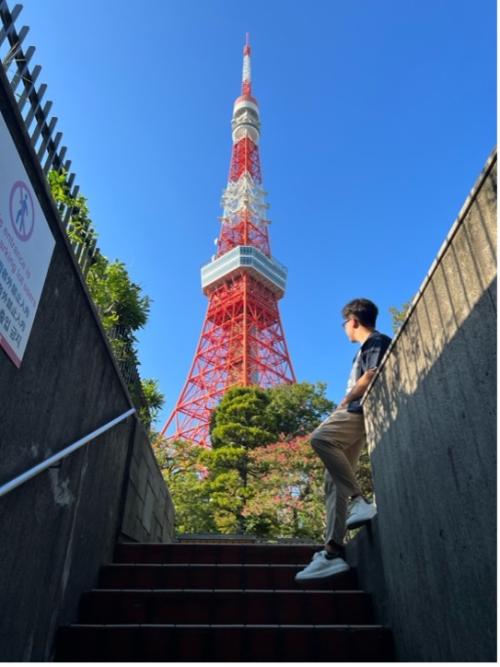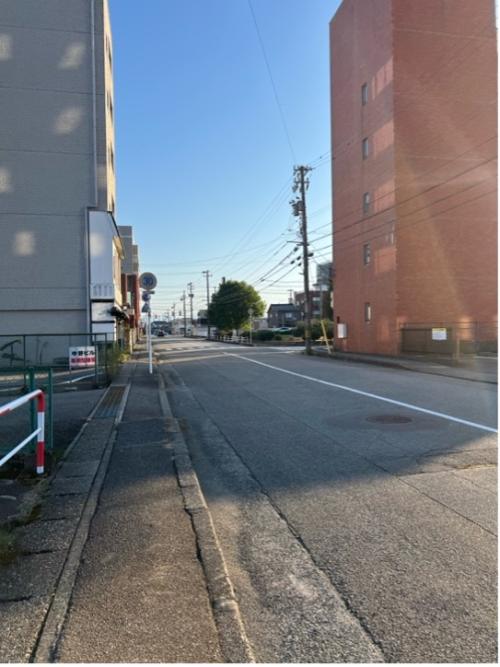
by David Junquan Zong, EAS-MA '24

When I started to write this travelogue, I was confused about how to write it so that it wouldn't lead to scattered topics, because there are so many places to see in Tokyo that it's almost impossible to describe them all in one travelogue. So I thought I'd condense the most representative and memorable sights in Tokyo into one day's travel arrangements, and then expand on that day to write about my life in Japan (not just in Tokyo) in Fall 2023.
ようこそ!東京へ!(Welcome to Tokyo!)
When the immigration officer at Haneda Airport said these words, I realized that my new journey was about to begin. After settling myself in the student apartment for foreign students provided by Meiji University, I'm starting to get to know this city.
One day in Tokyo
The day began in this bustling metropolis when I boarded the JR train, feeling overwhelmed by the crowded compartment. My first adventure was a visit to the historic Asakusa district. The sight of the iconic Kaminarimon Gate leading to Senso-ji, Tokyo's oldest temple, was striking against the backdrop of modern skyscrapers. Exploring the Nakamise shopping street, lined with stalls selling traditional Japanese crafts and snacks, was like stepping back in time. Lunch was a delightful affair in a local chukka ramen shop, where the rich broth and perfectly cooked noodles provided a comforting embrace.

photo by David Zong

photo by David Zong
The shift from Asakusa's historical charm to the futuristic Akihabara Electric Town was a testament to Tokyo's dynamic spirit. Akihabara's streets, alive with the glow of neon signs, were a paradise for lovers of anime, manga, and all things tech. Exploring the multi-story electronics stores and themed cafés was an adventure, showcasing the city's unique pop culture. It is then interesting to see that Cat cafes or maid cafes are commodified spaces where people go to participate in exciting or comfortable experiences alternative to the stressful reality of post-bubble Japan. Customer satisfaction does not then come from the purchase of a specific commodity, but rather the feelings and experiences that affective laborers cultivate in the relationship with their customers.


My visit to Tokyo Tower is like stepping into a frame of a postcard, where the city's heartbeat synchronizes with the flickering lights. Standing at the base, gazing up at the crimson-lit spire piercing the sky, you're struck by the monument's blend of futuristic ambition and nostalgic charm. The ascent in the elevator is a swift vertical pilgrimage, and at the summit, Tokyo unfurls below—a vast, living diorama. From this vantage point, the metropolis is a sea of illumination, a testament to human artistry and ambition.

photo by David Zong

photo by David Zong
As dusk fell, I found myself in the heart of Shibuya, witnessing the iconic Shibuya Crossing, often dubbed 'The Scramble.' Standing amidst the sea of people crossing in perfect chaos yet in harmony was a surreal experience. Dinner was in a cozy izakaya restaurant hidden down a narrow alley, a treasure trove of iconic Japanese food, from yakitori to sizzling okonomiyaki, accompanied by cheerful conversations with locals. The night ended with a visit to the observation deck of the Tokyo Metropolitan Government Building at Shinjuku, where the city's sprawling lights stretched into the horizon, a glittering reminder of Tokyo's endless possibilities.

photo by David Zong

photo by David Zong
Meiji University exchange experience
Commencing the Meiji University exchange program, the initial orientation provided an entryway to a dynamic and enriching cultural and academic immersion. As I traversed the vibrant Surugadai campus in the vicinity of Ochanomizu station, I was intrigued to observe that the campus is encircled by office buildings; this odd sensation gives me the impression that I may become to work as a サラリーマン (salaryman).
In addition, I enrolled in Campus Mate, an exciting initiative at Meiji University that facilitates interaction between Japanese and international students. A favored activity of mine is supporting the Meiji University soccer team while attending games. Collectively, we delighted in the euphoric ambiance, our voices harmonizing with those of the audience—a thrilling precursor to the rigorous intellectual pursuits that were to come.

photo by David Zong

photo by David Zong


photo by David Zong
At the heart of cultural exchange lies the Japanese language table, a noontime tradition where the clinking of chopsticks accompanies the melodic rise and fall of conversation. Japanese students, with native fluency, become mentors, guiding their foreign peers through the complexities of grammar and the intricacies of idiomatic expressions.
It's a place where language barriers are dismantled one word at a time, friendships are forged in the forges of dialogue, and the classroom's rigid structure gives way to the organic flow of cultural exchange.


Further, the anthropology seminar in graduate school, with its intricate discussions, proved to be the crucible where theoretical knowledge from Japanese scholars was tempered with real-world perspectives. In these halls of learning, amidst a mosaic of international minds, my academic pursuit transformed, enriched by the collective insight and the palpable spirit of Meiji University's scholarly community.

Solo traveling to rural places in hokuriku (北陸) area
Solo traveling often offers a unique lens through which to observe and contemplate the nuanced tapestry of life's social issues. In the serene solitude of Kanazawa, wandering through the historic districts, one can't help but ponder the delicate balance of preservation and modernity. Meanwhile, the tranquil vistas of Toyama, with its majestic mountains juxtaposed against industrial progress, invite introspection on the transient nature of human endeavor. Both cities, with their beauty and quietude, also serve as silent witnesses to the profound challenge of de-population. As one traverses these landscapes, the stillness seems to echo with the stories of those who once filled the streets, a contemplative backdrop to the solitude of the journey, reminding us that our solo travels are but a fleeting moment in the grand continuum of social histories.



For instance, on a certain day, I rode a tram from Toyama City to a neighboring city called Takaoka. The primary objective of the journey was solely to see a renowned Buddhist temple. However, during the hike towards my intended destination, I was astounded by the breathtaking environment that unfolded before me. The dilapidated buildings, overgrown parks, and sparsely populated walkways that I encountered along the trip served to renew my impression of the rural areas in this highly developed nation.
While traversing an intersection, I observed a grandfather who seemed to be regulating the flow of traffic, although there were few vehicles or pedestrians requiring passage through the intersection. During the period that I was waiting for the traffic light to change from red to green, I engaged in a brief conversation with him. Curiously, his repetitive statement indicated that the occurrence in the area was not caused by a natural or human-induced catastrophe. Instead, it was merely a coincidence that everyone had independently decided to leave the city in pursuit of a more favorable standard of living.
Ikigai (生き甲斐), which refers to the purpose of living, held particular significance as it appeared that everyone was compelled to depart.




As a matter of fact, almost every day in Japan was full of sensations, from the bustling markets and serene temples to the neon-lit streets of technology and fantasy.
Tokyo is a city that never seems to sleep, yet it retains pockets of tranquility and tradition amidst its rapid paces. It's a place where every corner holds a story, every street a different world. This city has taught me the beauty of balance, the dance between the old and the new, and the importance of embracing change while honoring the past. Tokyo, with its vibrant heart, has etched a vivid memory in my mind, one that I'll carry with me as a reminder of the day when I truly felt the pulse of this magnificent city.
However, it was impossible to overlook the significant disparity that the rural regions of Japan presented to me. The occurrence of a distinction among cities is well worth contemplating. And I would like to conclude with a question that arose in my mind during my journey: do I truly find myself in Japan?